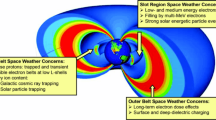Abstract
Pressure dependences of the volume scattering coefficient of aerosol in the atmosphere of Jupiter σ a (P) are presented. In calculations carried out with separating the gaseous and aerosol absorption, the absorption of light in the continuous spectrum was taken into account. In the analysis, the spectrophotometric data of Jupiter for the absorption bands of methane at 727 and 619 nm—the geometric albedo (measured in 1993) and the reflectivity of some latitudinal details (measured in 2013)—were used. At high tropospheric levels, in the pressure range from 0.4 to 2 bar, the dependences σ a (P) for the integral disk and latitude belts of the giant planet turned out to be similar. In this part of the atmosphere, the three thickest cloud layers were found; in these layers, within the pressure range from 0.8 to 1.33 bar in the North and South Temperature Belts (NTB and STB), respectively, the values of the coefficient σ a (P) are maximum. In the pressure interval from 2 to 4 bar, in the analyzed latitude belts except the NTB and STB, the forth aerosol layer was found; its altitude position and vertical structure substantially differ from belt to belt. One more aerosol layer probably exists deeper in the atmosphere; its initial level and extension differ in different latitude belts. Most of the investigated latitude belts exhibit the spectral dependence of σ a (P) at the atmospheric levels, where the pressure exceeds 3 bar. This probably points to the change in size or nature of aerosol particles.
Similar content being viewed by others
References
N. N. Bondarenko, “The study of the ammonia NH3 787nm absorption band in Jupiter’s atmosphere,” Izv. Akad. Nauk Resp. Kaz., Ser. Fiz.-Mat., No. 3, 67–71 (2012).
A. V. Morozhenko, “The results of the polarization studies of Jupiter,” Astrom. Astrofiz., No. 30, 47–54 (1976).
A. V. Morozhenko, “On the structure of the Jupiter’s cloud layer,” Pis’ma Astron. Zh. 10, 775–779 (1984).
A. V. Morozhenko, A. S. Ovsak, A. P. Vid’machenko, V. G. Teifel, and P. G. Lysenko, “Imaginary part of the refractive index of aerosol in latitudinal belts of Jupiter’s disc,” Kinematics Phys. Celestial Bodies 32, 43–55 (2016).
V. G. Teifel’ and G. A. Kharitonova, “The particularities of the methane absorption distribution on Jupiter from data of quasicontinuous overlapping of all planetary latitudes,” Izv. Akad. Nauk Resp. Kaz., Ser. Fiz.-Mat., No. 5, 93–98 (2013).
Physical Characteristics of the Giant Planets, Ed. by V. G. Teifel’ (Nauka, Alma-Ata, 1971; NASA, Washington, DC, 1972), p. 70.
G. L. Bjoraker, M. H. Wong, I. de Pater, and M. Adamkovics, “Jupiter’s deep cloud structure revealed using Keck observations of spectrally resolved line shapes,” Astrophys. J. 810, 122 (1998).
N. Chanover, A. Simon, and R. Hudson, “Colors in the giant planet atmospheres,” in Proc. AGU Chapman Conf. on Crossing Boundaries in Planetary Atmospheres: From Earth to Exoplanets, Annapolis, MD, June 24–28, 2013 (AGU, 2013), abstract T-21.
J. M. Dlugach and E. G. Yanovitskij, “The optical properties of Venus and the Jovian planets. II. Methods and results of calculations of the intensity of radiation diffusely reflected from semi-infinite homogeneous atmospheres,” Icarus 22, 66–81 (1974).
R. S. Giles, L. N. Fletcher, and P. G. J. Irwin, “Cloud structure of Jupiter’s troposphere from Cassini VIMS,” in Proc. American Astronomical Society, 46th Meeting of the Division for Planetary Sciences, Tuscon, AZ, Nov. 9–14, 2014 (Am. Astronom. Soc., 2014), abstract 511.02.
E. Karkoschka, “Spectrophotometry of the Jovian planets and Titan at 300- to 1000-nm wavelength: The methane spectrum,” Icarus 111, 967–982 (1994).
E. Karkoschka, “Methane, ammonia, and temperature measurements of the Jovian planets and Titan from CCD-spectrophotometry,” Icarus 133, 134–146 (1998).
G. F. Lindal, “The atmosphere of Neptune–An analysis of radio occultation data acquired with Voyager 2,” Astron. J. 103, 967–982 (1992).
M. J. Loeffler, R. L. Hudson, N. J. Chanover, and A. A. Simon, “Giant-planet chemistry: Ammonium hydrosulfide (NH4SH), its IR spectra and thermal and radiolytic stabilities,” Icarus 258, 181–191 (2015).
K. I. Matcheva, B. J. Conrath, P. J. Gierash, and F. M. Flasar, “The cloud structure of the Jovian atmosphere as seen by the Cassini/CIRS experiment,” Icarus 179, 432–448 (2005).
M. I. Mishchenko, “Physical properties of the upper tropospheric aerosols in the equatorial region of Jupiter,” Icarus 84, 296–304 (1990).
M. I. Mishchenko, “The FORTRAN code for computing the scattering of an ensemble of polydisperse, homogeneous spherical particles is based on the Lorenz-Mie theory.” http://wwwgissnasagov/staff/mmishchenko/ftpcode/spherf.
F. Moreno, R. Rodrigo, A. Sanchez-Lavega, and A. Molina, “Spectroscopic observations of the CH4-6190 Å and NH3-6450 Å absorption bands at different regions of the Jovian disk,” Astron. Astrophys., Suppl. Ser. 74, 233–238 (1988).
A. V. Morozhenko, “New determination of monochromatic methane absorption coefficients with regard to the thermal conditions in the atmospheres of giant planets. IV. Jupiter and Saturn,” Kinematics Phys. Celestial Bodies 23, 245–257 (2007).
A. V. Morozhenko and A. S. Ovsak, “On the possibility of separation of aerosol and methane absorption in the long-wavelength spectral range for giant planets,” Kinematics Phys. Celestial Bodies 31, 225–231 (2015).
A. V. Morozhenko and E. G. Yanovitskij, “The optical properties of Venus and the Jovian planets I. The atmosphere of Jupiter according to polarimetric observations,” Icarus 18, 583–592 (1973).
A. V. Morozhenko and E. G. Yanovitskii, “Vertical structure parameters for the upper layers of the Jovian atmosphere,” Sov. Astron. Lett. 2, 218–220 (1976).
H. B. Niemann, S. K. Atreya, G. R. Carignan, et al., “The composition of the Jovian atmosphere as determined by the Galileo probe mass spectrometer,” J. Geophys. Res.: Planets 103, 22831–22845 (1998).
A. S. Ovsak, “Calculation of effective optical depth of absorption line formation in homogeneous semi-infinite planetary atmosphere during anisotropic scattering,” Kinematics Phys. Celestial Bodies 26, 86–88 (2010).
A. S. Ovsak, “Upgraded technique to analyze the vertical structure of the aerosol component of the atmospheres of giant planets,” Kinematics Phys. Celestial Bodies 29, 291–300 (2013).
A. S. Ovsak, “Changes in the characteristics of the upper layers of the Jovian atmosphere from the data on the integral observations of the planetary disk,” Kinematics Phys. Celestial Bodies 31, 25–32 (2015).
A. S. Ovsak, “Variations of the volume scattering coefficient of aerosol in the Jovian atmosphere from observations of the planetary disk,” Kinematics Phys. Celestial Bodies 31, 197–204 (2015).
A. S. Ovsak, “Vertical structure of cloud layers in the atmospheres of giant planets. I. On the influence of variations of some atmospheric parameters on the vertical structure characteristics,” Sol. Syst. Res. 49, 43–50 (2015).
O. Ovsak and N. Kostogryz, “The method of computer analysis a vertical structure of aerosole component in the atmospheres of the giant planets,” in Proc. AGU Chapman Conf. on Crossing Boundaries in Planetary Atmospheres: From Earth to Exoplanets, Annapolis, MD, June 24–28, 2013 (AGU, 2013), abstract W3.
A. S. Ovsak, V. G. Teifel, A. P. Vid’machenko, and P. G. Lysenko, “Zonal differences in the vertical structure of the cloud cover of Jupiter from the measurements of the methane absorption bands at 727 and 619 nm,” Kinematics Phys. Celestial Bodies 31, 119–130 (2015).
B. Ragent, D. S. Colburn, K. A. Rages, et al., “The clouds of Jupiter: Results of the Galileo Jupiter mission probe nephelometer experiment,” J. Geophys. Res.: Planets 103, 22891–22909 (1998).
J. Rojas, J. Arreg, E. Garcia-Melendo, et al., “New measurements of Jupiter’s Equatorial Region in visible wavelengths,” Bull. Am. Astron. Soc. 42, 1017 (2010).
A. Seiff, D. B. Kirk, T. C. D. Knight, et al., “Thermal structure of Jupiter’s atmosphere near the edge of a 5-µm hot spot in the north equatorial belt,” J. Geophys. Res.: Planets 103, 22857–22889 (1998).
A. A. Simon, A. Sanchez-Lavega, J. Legarreta, R. W. Carlson, et al., “Spectral comparison and stability of red regions on Jupiter,” J. Geophys. Res.: Planets 120, 483–494 (2015).
V. G. Teifel, “Molecular absorption and the possible structure of the cloud layers of Jupiter and Saturn,” J. Atmos. Sci. 26, 854–859 (1969).
V. G. Teifel, “The morphology of molecular absorption on disk on Jupiter,” in Jupiter: Studies of the Interior, Atmosphere, Magnetosphere and Satellites: Proc. Colloquium, Tucson, Arizona, May 19–21, 1975, Ed. by T. Gerels (Univ. Arizona Press, Tucson, 1976; Mir, Moscow, 1978–1979), pp. 441–485.
V. G. Teifel, “The mapping of longitudinal-latitudinal variations of the methane absorption on Jupiter,” Bull. Am. Astron. Soc. 32, 1007 (2000).
V. G. Teifel, G. A. Kharitonova, and G. I. Khudiaeva, “Zonal spectrophotometric properties of the Jovian cloud cover,” Sol. Syst. Res. 15, 71–78 (1981).
R. A. West and M. G. Tomasko, “Spatially resolved methane band photometry of Jupiter: III. Cloud vertical structures for several axisymmetric bands and the Great Red Spot,” Icarus 41, 278–292 (1980).
E. G. Yanovitskij and A. S. Ovsak, “Effective optical depth of absorption line formation in semi-infinite planetary atmosphere,” Kinematika Fiz. Nebesnykh Tel 13 (4), 3–21 (1997).
Author information
Authors and Affiliations
Corresponding author
Additional information
Original Russian Text © A.S. Ovsak, V.G. Teifel, P.G. Lysenko, 2016, published in Kinematika i Fizika Nebesnykh Tel, 2016, Vol. 32, No. 4, pp. 36–47.
About this article
Cite this article
Ovsak, A.S., Teifel, V.G. & Lysenko, P.G. Vertical structure of the volume scattering coefficient of aerosol in latitude belts of Jupiter’s disk. Kinemat. Phys. Celest. Bodies 32, 181–188 (2016). https://doi.org/10.3103/S0884591316040061
Received:
Published:
Issue Date:
DOI: https://doi.org/10.3103/S0884591316040061




